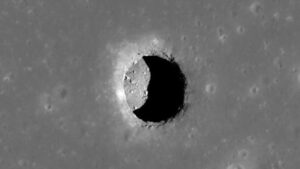The clouds on Neptune disappeared in 2020 and astronomers were flummoxed. They had been watching the clouds on the planet decrease since 2019 and within months they vanished. Researchers began working on the mystery of the fading clouds and now they think they have an answer: the clouds are linked to the solar cycle.
Neptune waxes and wanes
The research team trawled through almost three decades worth of data and observations of the icy planet. The new study shows this is not the first time the clouds have disappeared. Neptune appears brighter when the clouds of frozen methane are present and get progressively darker as they fade. In the latest cycle, Neptune was at its brightest in 2015 and gradually darkened until 2020. By 2020, it had the lowest light levels recorded.

Hubble Space Telescope images show the rise and fall of cloud cover on Neptune alongside a measure of UV radiation. Image: NASA, ESA, LASP, Erandi Chavez (UC Berkeley), Imke de Pater (UC Berkeley)
Neptune seemed to have full cloud cover in 2002, but this gradually reduced until 2007. After this, the clouds started to build again. The pattern repeats throughout the data set. The planet looks brighter when there is a higher cloud cover as the clouds reflect more sunlight.
However, this cycle does seem to be slightly different, it is taking longer for the clouds to return than expected. At the moment, there are just a few clouds over the south pole of the planet. “Even now, four years later, the most recent images we took this past June still show the clouds haven’t returned to their former levels…Neptune’s previous period of low cloud activity was not nearly as dramatic and prolonged,” the study’s lead author Erandi Chavez told CNN.
Linked to the Sun’s 11-year cycle
The team believes that the cloud cover depends on the Sun’s 11-year solar cycle. “Our findings support the theory that the Sun’s [ultraviolet] rays, when strong enough, may be triggering a photochemical reaction that produces Neptune’s clouds,” co-author Imke de Pater told NASA.
The relationship between the Sun’s cycle and Neptune surprised scientists because they are so far apart. In our solar system, Neptune is the furthest planet from the sun and receives only 0.1% of the light intensity we receive on Earth.
There is a two-year lag between the solar cycle and the effect it has on Neptune’s clouds. The solar cycle describes how the Sun’s magnetic field changes over time. Every 11 years, it flips and reverses its polarity so that the north pole becomes the south pole, or vice versa. Over the 11 years, sunspots and flare activity increases until the magnetic field breaks down and the polarity flips. Then the cycle begins again.
As UV radiation from the sun intensifies, so does cloud cover on Neptune, with a two-year delay. Researchers think the amount of UV radiation at the solar peak triggers a photochemical reaction as Neptune absorbs the light energy. It is also possible that this reaction takes approximately two years, which would neatly explain the time lag.
The clouds on Neptune should now start to return as we progress through the next solar cycle.






